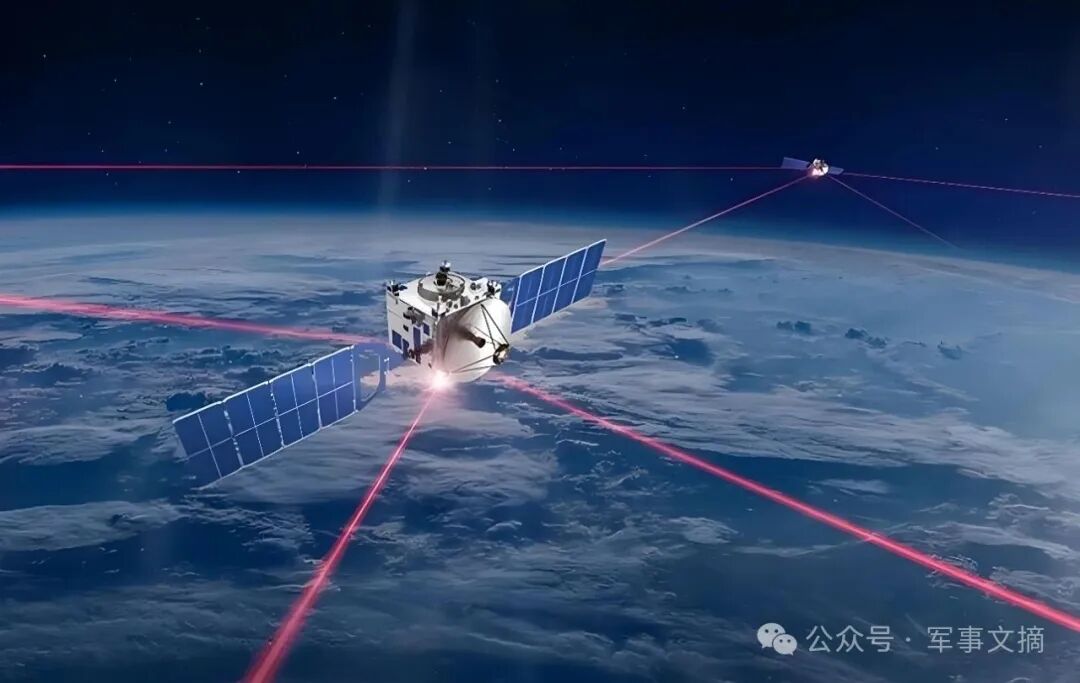
 With the rapid development of space technology and the continuous changes in international security situations, the space domain has gradually become a new focus of great power competition. The US “Star Shield” system, with its technological advantages of a large low-orbit satellite constellation and military-specific characteristics, has become one of the representative projects of the emerging space security architecture, attracting significant attention from countries around the world. The “Star Shield” system adds functions such as ground reconnaissance and surveillance, and military payload hosting on the basis of traditional military satellite communications. This article analyzes the characteristics of the “Star Shield” system and, in conjunction with the relevant measures taken by the US government and military, conducts an in-depth study of the development trends of the “Star Shield” system, which can provide references for addressing new forms of space security challenges.Analysis of the Characteristics of the “Star Shield” SystemThe “Star Shield” system further optimizes its functions by “marrying” and expanding the technology of the “Starlink” system. Based on the development of the “Starlink” V2.0 satellites, the “Star Shield” system significantly enhances its adaptability in a complex battlefield environment characterized by strong confrontation and rapid pace through measures such as improving communication confidentiality and anti-jamming capabilities, modular payload design, autonomous satellite attitude control, damage-resistant architecture design, and rapid production and replenishment launch strategies.High-Speed Communication Interconnection The “Star Shield” system achieves high-speed communication interconnection through full constellation interconnection and distributed network architecture, possessing the core functions of modern battlefield information systems.Full Constellation Interconnection and Self-Healing Network Architecture. The “Star Shield” forms a highly resilient and damage-resistant self-healing network architecture through inter-satellite laser communication links. This design allows the network to automatically adjust communication paths based on dynamic changes in nodes. When certain nodes lose functionality due to faults or attacks, the system can quickly replan data transmission paths, avoiding damaged nodes and ensuring uninterrupted communication. Compared to traditional high-orbit communication satellites, this distributed design of the “Star Shield” system significantly reduces the risk of network interruption and enhances the overall resilience of the system.High Bandwidth and Low Latency. The “Star Shield” system network achieves high-capacity data transmission based on inter-satellite links, with each satellite’s communication bandwidth reaching 200 gigabits per second and latency reduced to below 20 milliseconds, significantly outperforming traditional high-orbit communication satellites. This capability meets the US military’s demand for high-speed, real-time data transmission. For example, in joint all-domain operations, this high bandwidth and low latency communication capability can enable situational sharing and rapid response among various operational units.
With the rapid development of space technology and the continuous changes in international security situations, the space domain has gradually become a new focus of great power competition. The US “Star Shield” system, with its technological advantages of a large low-orbit satellite constellation and military-specific characteristics, has become one of the representative projects of the emerging space security architecture, attracting significant attention from countries around the world. The “Star Shield” system adds functions such as ground reconnaissance and surveillance, and military payload hosting on the basis of traditional military satellite communications. This article analyzes the characteristics of the “Star Shield” system and, in conjunction with the relevant measures taken by the US government and military, conducts an in-depth study of the development trends of the “Star Shield” system, which can provide references for addressing new forms of space security challenges.Analysis of the Characteristics of the “Star Shield” SystemThe “Star Shield” system further optimizes its functions by “marrying” and expanding the technology of the “Starlink” system. Based on the development of the “Starlink” V2.0 satellites, the “Star Shield” system significantly enhances its adaptability in a complex battlefield environment characterized by strong confrontation and rapid pace through measures such as improving communication confidentiality and anti-jamming capabilities, modular payload design, autonomous satellite attitude control, damage-resistant architecture design, and rapid production and replenishment launch strategies.High-Speed Communication Interconnection The “Star Shield” system achieves high-speed communication interconnection through full constellation interconnection and distributed network architecture, possessing the core functions of modern battlefield information systems.Full Constellation Interconnection and Self-Healing Network Architecture. The “Star Shield” forms a highly resilient and damage-resistant self-healing network architecture through inter-satellite laser communication links. This design allows the network to automatically adjust communication paths based on dynamic changes in nodes. When certain nodes lose functionality due to faults or attacks, the system can quickly replan data transmission paths, avoiding damaged nodes and ensuring uninterrupted communication. Compared to traditional high-orbit communication satellites, this distributed design of the “Star Shield” system significantly reduces the risk of network interruption and enhances the overall resilience of the system.High Bandwidth and Low Latency. The “Star Shield” system network achieves high-capacity data transmission based on inter-satellite links, with each satellite’s communication bandwidth reaching 200 gigabits per second and latency reduced to below 20 milliseconds, significantly outperforming traditional high-orbit communication satellites. This capability meets the US military’s demand for high-speed, real-time data transmission. For example, in joint all-domain operations, this high bandwidth and low latency communication capability can enable situational sharing and rapid response among various operational units. The “Star Shield” system network based on inter-satellite linksachieves high-capacity data transmissionEnhanced Communication Encryption and Anti-Jamming Capabilities. In military communications, confidentiality and anti-jamming capabilities are crucial indicators. The “Star Shield” system significantly enhances these two key capabilities through various technical means.Improved Encryption Standards. The “Star Shield” system employs encryption algorithms with strength exceeding the AES-256 military standard, effectively preventing critical data from being eavesdropped or tampered with during transmission. Additionally, the onboard hardware encryption module ensures end-to-end encrypted transmission from the satellite to ground terminals, greatly enhancing communication security. This advanced encryption design not only improves the ability to resist network attacks but also effectively counters potential threats from quantum computing decryption.Upgraded Anti-Jamming Capabilities. To cope with potential electronic interference, the “Star Shield” system has upgraded its phased array antennas and signal processing technologies. By updating phase shifter chips and beamforming strategies, the system can dynamically adjust signal directions, reducing the impact of interference sources on communication links. Furthermore, the beamforming capability of the phased array antennas allows the “Star Shield” system to simultaneously track multiple targets and maintain high-quality communication connections, even in strong electronic interference environments, ensuring high data transmission rates.Flexible Customization of Payload Hosting The “Star Shield” system adopts a generalized low-orbit satellite platform and modular design to meet diverse mission requirements through flexible payload configurations.Modular Design and Stacked Connections. The satellites of the “Star Shield” system achieve flexible customization through modular payload design. Users can select different types of payloads (such as optical imaging, infrared remote sensing, electronic reconnaissance, etc.) based on specific needs and quickly complete satellite assembly through stacked connections. This design significantly shortens the satellite production cycle and greatly reduces deployment costs.Compatibility of Extended Payloads. Unlike the “Starlink” system satellites, which only support payloads from SpaceX, the satellites of the “Star Shield” system are designed to be compatible with third-party payload interfaces. This open design allows them to adapt to the needs of different countries or organizations, flexibly carrying various types of mission payloads, thereby providing the US military with stronger mission execution capabilities in multi-domain operations.Autonomous Operation and Damage Resistance of Satellites To cope with complex battlefield environments, the “Star Shield” system has strengthened the autonomous operation capabilities and damage resistance of its satellites.Autonomous Operation and Mission Completion Assurance. By upgrading inter-satellite laser communication links and satellite attitude control systems, the “Star Shield” system reduces reliance on ground stations. Even in cases of lost contact with the ground, satellites can still complete some missions. This autonomous operation capability allows the “Star Shield” system to maintain basic functions even when some satellite hardware is damaged, ensuring mission continuity and system stability.Adopting Damage-Resistant Design. The “Star Shield” system achieves “decentralization” of network functions through the large-scale deployment of low-cost satellites. Even if individual nodes are destroyed in conflict, the overall system can still operate normally. Moreover, the low-orbit operational characteristics and rapid maneuverability of the satellites make them harder to target, thus ensuring their survivability in high-intensity confrontations.Rapid Production and Replenishment Launch Low cost and rapid deployment are another important feature of the “Star Shield” system, enabling it to quickly restore system functionality during wartime.Rapid Production Model. The “Star Shield” system leverages SpaceX’s technological accumulation in satellite miniaturization and standardized manufacturing, ensuring that “Star Shield” satellites can be produced and tested in a short time through an efficient assembly line production model. This industrialized production method significantly reduces the cost of each satellite, making large-scale constellation deployment possible.Ability to Implement Replenishment Launch Strategies. Relying on SpaceX’s rapid launch capabilities, the “Star Shield” system can quickly launch backup satellites for replenishment in case of attacks or failures. SpaceX’s Falcon series rockets have high launch frequency and payload capacity, providing strong support for the “Star Shield” system’s rapid replenishment in emergencies. This strategy greatly enhances the overall resilience and recovery capability of the system, enabling it to respond to sudden battlefield demands.Specific Measures to Accelerate the Development of the “Star Shield” System in the USThe US places great importance on the development of the “Star Shield” system. The US government and military have taken multiple measures in terms of policy regulations and funding investment to provide full support to SpaceX and conduct prototype trials within the military, aiming to achieve the military application of the “Star Shield” system as soon as possible.Policy Support. Since 2019, the US military has issued a series of strategic guidance documents related to space force construction, continuously promoting cooperation between the military and commercial low-orbit satellite companies, providing a favorable policy environment for the operation of the “Star Shield” system.Documents such as the US “National Space Strategy”, “Summary of the US Defense Space Strategy”, and “National Space Policy” clearly outline the US goals in civil space exploration and national security, increasing the defense budget for space armed forces and accelerating the construction of space-based military capabilities. In 2024, the US Department of Defense’s “Department of Defense Commercial Space Integration Strategy” stated that it would integrate commercial space solutions into the US national security space architecture to coordinate the US space launch, transportation, maneuvering, and other space-based mission needs. This ensures that commercial space solutions can be applied in various conflicts, completing the integration of commercial space capabilities before potential wars, establishing relevant security and support conditions for the integration of new commercial space solutions, and supporting the research and development of new commercial space solutions to meet the evolving joint operational needs. In April 2024, the US Space Force released its “Commercial Space Strategy”, seeking to deepen the connection between US defense agencies and the commercial sector. This strategy aims to clarify the cooperation norms between the Space Force and the commercial sector, promote the development of more resilient and combat-capable architectures, and support low-cost, rapid response, and large-scale deployment.
The “Star Shield” system network based on inter-satellite linksachieves high-capacity data transmissionEnhanced Communication Encryption and Anti-Jamming Capabilities. In military communications, confidentiality and anti-jamming capabilities are crucial indicators. The “Star Shield” system significantly enhances these two key capabilities through various technical means.Improved Encryption Standards. The “Star Shield” system employs encryption algorithms with strength exceeding the AES-256 military standard, effectively preventing critical data from being eavesdropped or tampered with during transmission. Additionally, the onboard hardware encryption module ensures end-to-end encrypted transmission from the satellite to ground terminals, greatly enhancing communication security. This advanced encryption design not only improves the ability to resist network attacks but also effectively counters potential threats from quantum computing decryption.Upgraded Anti-Jamming Capabilities. To cope with potential electronic interference, the “Star Shield” system has upgraded its phased array antennas and signal processing technologies. By updating phase shifter chips and beamforming strategies, the system can dynamically adjust signal directions, reducing the impact of interference sources on communication links. Furthermore, the beamforming capability of the phased array antennas allows the “Star Shield” system to simultaneously track multiple targets and maintain high-quality communication connections, even in strong electronic interference environments, ensuring high data transmission rates.Flexible Customization of Payload Hosting The “Star Shield” system adopts a generalized low-orbit satellite platform and modular design to meet diverse mission requirements through flexible payload configurations.Modular Design and Stacked Connections. The satellites of the “Star Shield” system achieve flexible customization through modular payload design. Users can select different types of payloads (such as optical imaging, infrared remote sensing, electronic reconnaissance, etc.) based on specific needs and quickly complete satellite assembly through stacked connections. This design significantly shortens the satellite production cycle and greatly reduces deployment costs.Compatibility of Extended Payloads. Unlike the “Starlink” system satellites, which only support payloads from SpaceX, the satellites of the “Star Shield” system are designed to be compatible with third-party payload interfaces. This open design allows them to adapt to the needs of different countries or organizations, flexibly carrying various types of mission payloads, thereby providing the US military with stronger mission execution capabilities in multi-domain operations.Autonomous Operation and Damage Resistance of Satellites To cope with complex battlefield environments, the “Star Shield” system has strengthened the autonomous operation capabilities and damage resistance of its satellites.Autonomous Operation and Mission Completion Assurance. By upgrading inter-satellite laser communication links and satellite attitude control systems, the “Star Shield” system reduces reliance on ground stations. Even in cases of lost contact with the ground, satellites can still complete some missions. This autonomous operation capability allows the “Star Shield” system to maintain basic functions even when some satellite hardware is damaged, ensuring mission continuity and system stability.Adopting Damage-Resistant Design. The “Star Shield” system achieves “decentralization” of network functions through the large-scale deployment of low-cost satellites. Even if individual nodes are destroyed in conflict, the overall system can still operate normally. Moreover, the low-orbit operational characteristics and rapid maneuverability of the satellites make them harder to target, thus ensuring their survivability in high-intensity confrontations.Rapid Production and Replenishment Launch Low cost and rapid deployment are another important feature of the “Star Shield” system, enabling it to quickly restore system functionality during wartime.Rapid Production Model. The “Star Shield” system leverages SpaceX’s technological accumulation in satellite miniaturization and standardized manufacturing, ensuring that “Star Shield” satellites can be produced and tested in a short time through an efficient assembly line production model. This industrialized production method significantly reduces the cost of each satellite, making large-scale constellation deployment possible.Ability to Implement Replenishment Launch Strategies. Relying on SpaceX’s rapid launch capabilities, the “Star Shield” system can quickly launch backup satellites for replenishment in case of attacks or failures. SpaceX’s Falcon series rockets have high launch frequency and payload capacity, providing strong support for the “Star Shield” system’s rapid replenishment in emergencies. This strategy greatly enhances the overall resilience and recovery capability of the system, enabling it to respond to sudden battlefield demands.Specific Measures to Accelerate the Development of the “Star Shield” System in the USThe US places great importance on the development of the “Star Shield” system. The US government and military have taken multiple measures in terms of policy regulations and funding investment to provide full support to SpaceX and conduct prototype trials within the military, aiming to achieve the military application of the “Star Shield” system as soon as possible.Policy Support. Since 2019, the US military has issued a series of strategic guidance documents related to space force construction, continuously promoting cooperation between the military and commercial low-orbit satellite companies, providing a favorable policy environment for the operation of the “Star Shield” system.Documents such as the US “National Space Strategy”, “Summary of the US Defense Space Strategy”, and “National Space Policy” clearly outline the US goals in civil space exploration and national security, increasing the defense budget for space armed forces and accelerating the construction of space-based military capabilities. In 2024, the US Department of Defense’s “Department of Defense Commercial Space Integration Strategy” stated that it would integrate commercial space solutions into the US national security space architecture to coordinate the US space launch, transportation, maneuvering, and other space-based mission needs. This ensures that commercial space solutions can be applied in various conflicts, completing the integration of commercial space capabilities before potential wars, establishing relevant security and support conditions for the integration of new commercial space solutions, and supporting the research and development of new commercial space solutions to meet the evolving joint operational needs. In April 2024, the US Space Force released its “Commercial Space Strategy”, seeking to deepen the connection between US defense agencies and the commercial sector. This strategy aims to clarify the cooperation norms between the Space Force and the commercial sector, promote the development of more resilient and combat-capable architectures, and support low-cost, rapid response, and large-scale deployment. Cover of the US Military’s “Defense Space Strategy” In terms of spectrum management, the US Federal Communications Commission continues to open more spectrum to SpaceX, helping the “Star Shield” system improve spectrum efficiency and enhance its ability to deploy high-quality internet services. In March 2024, the US Federal Communications Commission approved SpaceX’s use of E-band frequencies between the “Starlink” V2.0 satellites and ground gateways, as well as previously approved Ka and Ku-band frequencies for communication, to increase constellation capacity. The FCC opened the 71-76 GHz and 81-86 GHz bands for communication with SpaceX’s 7500 “Starlink” V2.0 satellites. In September 2024, the FCC further opened the 17.3-17.7 GHz frequency band for non-geostationary satellite operators like SpaceX to provide satellite communication services to fixed points on Earth.Funding Assurance. After the official launch of the “Star Shield” system, the US military has signed multiple contracts with SpaceX to procure services for the “Star Shield” system and support its construction. In 2023, the US National Reconnaissance Office publicly disclosed an $1.8 billion contract for “Star Shield” services signed secretly with SpaceX. According to the contract, SpaceX is to develop and launch 100 “Star Shield” satellites to establish a spy satellite network system capable of continuous real-time detection and target tracking, providing enhanced global observation capabilities for the US government and military, and supporting US military ground operations around the clock. The US Space Force signed a one-year, $70 million service contract for the “Star Shield” system, providing communication services for dozens of Department of Defense partners. The Department of Defense signed a $15 million service contract for the “Star Shield” system, providing end-to-end communication services for 54 military partners. In 2024, the Department of Defense submitted a budget request to procure over 100 “Star Shield” satellites by 2029 to build a military communication system and expand its future satellite communication architecture, enhancing the US military’s space-based intelligence, surveillance, and reconnaissance capabilities.Pilot Promotion. The US military is continuously advancing the testing and application process of the “Star Shield” system through the early deployment of prototype satellites for small-scale military testing.Before the official launch of the “Star Shield” system, the US military secretly signed contracts with SpaceX to develop and launch multiple prototype satellites for the “Star Shield” system, verifying key technologies related to military communications and ground observation to assess the performance of the “Star Shield” system in actual operations, identify and resolve potential technical issues, and help the “Star Shield” system better meet military application needs, thereby reducing risks after large-scale deployment and advancing the practical application process.
Cover of the US Military’s “Defense Space Strategy” In terms of spectrum management, the US Federal Communications Commission continues to open more spectrum to SpaceX, helping the “Star Shield” system improve spectrum efficiency and enhance its ability to deploy high-quality internet services. In March 2024, the US Federal Communications Commission approved SpaceX’s use of E-band frequencies between the “Starlink” V2.0 satellites and ground gateways, as well as previously approved Ka and Ku-band frequencies for communication, to increase constellation capacity. The FCC opened the 71-76 GHz and 81-86 GHz bands for communication with SpaceX’s 7500 “Starlink” V2.0 satellites. In September 2024, the FCC further opened the 17.3-17.7 GHz frequency band for non-geostationary satellite operators like SpaceX to provide satellite communication services to fixed points on Earth.Funding Assurance. After the official launch of the “Star Shield” system, the US military has signed multiple contracts with SpaceX to procure services for the “Star Shield” system and support its construction. In 2023, the US National Reconnaissance Office publicly disclosed an $1.8 billion contract for “Star Shield” services signed secretly with SpaceX. According to the contract, SpaceX is to develop and launch 100 “Star Shield” satellites to establish a spy satellite network system capable of continuous real-time detection and target tracking, providing enhanced global observation capabilities for the US government and military, and supporting US military ground operations around the clock. The US Space Force signed a one-year, $70 million service contract for the “Star Shield” system, providing communication services for dozens of Department of Defense partners. The Department of Defense signed a $15 million service contract for the “Star Shield” system, providing end-to-end communication services for 54 military partners. In 2024, the Department of Defense submitted a budget request to procure over 100 “Star Shield” satellites by 2029 to build a military communication system and expand its future satellite communication architecture, enhancing the US military’s space-based intelligence, surveillance, and reconnaissance capabilities.Pilot Promotion. The US military is continuously advancing the testing and application process of the “Star Shield” system through the early deployment of prototype satellites for small-scale military testing.Before the official launch of the “Star Shield” system, the US military secretly signed contracts with SpaceX to develop and launch multiple prototype satellites for the “Star Shield” system, verifying key technologies related to military communications and ground observation to assess the performance of the “Star Shield” system in actual operations, identify and resolve potential technical issues, and help the “Star Shield” system better meet military application needs, thereby reducing risks after large-scale deployment and advancing the practical application process. SpaceX launching satellitesAfter the launch of the “Star Shield” system, the US military is actively conducting tests and deployments of the “Star Shield” system, piloting its application in the Army, Air Force, and Marine Corps, testing its communication security and reliability in military operations. Meanwhile, due to the small scale of the “Star Shield” system, the US military continues to use the “Starlink” system for military communication capability verification, utilizing battlefield testing and exercises to continuously identify issues in the military applications of the “Starlink” system, conducting system upgrades and optimizations to facilitate a rapid transition to the “Star Shield” system. In 2023, the US military conducted a nine-month military test of the “Starlink” system in the Arctic region. In 2024, the US Navy continued to expand the military application of the “Starlink” system, equipping hundreds of surface vessels and dozens of overseas port bases with “Starlink” system terminals.
SpaceX launching satellitesAfter the launch of the “Star Shield” system, the US military is actively conducting tests and deployments of the “Star Shield” system, piloting its application in the Army, Air Force, and Marine Corps, testing its communication security and reliability in military operations. Meanwhile, due to the small scale of the “Star Shield” system, the US military continues to use the “Starlink” system for military communication capability verification, utilizing battlefield testing and exercises to continuously identify issues in the military applications of the “Starlink” system, conducting system upgrades and optimizations to facilitate a rapid transition to the “Star Shield” system. In 2023, the US military conducted a nine-month military test of the “Starlink” system in the Arctic region. In 2024, the US Navy continued to expand the military application of the “Starlink” system, equipping hundreds of surface vessels and dozens of overseas port bases with “Starlink” system terminals. In 2023, the US military conducted a nine-month military test of the “Starlink” system in the Arctic region.Predictions on the Development Trends of the “Star Shield” SystemThe “Star Shield” system is currently in an immature construction phase and is gradually expanding in scale and iterating upgrades with the support of the US military. Based on existing information, further assessments can be made regarding its future construction development trends and characteristics.The number of satellites in the “Star Shield” system will further increase. The number of satellites already launched and deployed in the “Star Shield” system is limited. Based on the existing situation of the “Starlink” system, to achieve its intended all-time, all-domain coverage and monitoring functions, the constellation should reach a scale of at least about 4000 satellites. Therefore, the US military will undoubtedly accelerate the satellite launch and deployment pace of the “Star Shield” to continuously expand the satellite network scale, enhancing the network’s coverage and service quality. The US is attempting to replace high-value units with low-value, flexibly deployable space combat units, that is, replacing geostationary satellites with low-earth orbit satellites. The Department of Defense has begun to promote near-Earth orbit satellite deployment plans and aims to establish a government-exclusive “Star Shield” satellite constellation by 2029. In September 2022, then-Director of the US Space Development Agency Derek Turner stated that the US Space Force plans to eliminate geostationary orbit and large, expensive satellites in its future missile warning system, focusing on developing satellites in low Earth orbit. It is evident that the trend of US missile defense warning development has already pointed towards low-orbit satellites. The global communication and remote sensing functions provided by the “Star Shield” system have very high requirements for its global coverage capability, and continuously enhancing its satellite network’s global coverage capability is a necessary foundation for the “Star Shield” to realize its service functions.
In 2023, the US military conducted a nine-month military test of the “Starlink” system in the Arctic region.Predictions on the Development Trends of the “Star Shield” SystemThe “Star Shield” system is currently in an immature construction phase and is gradually expanding in scale and iterating upgrades with the support of the US military. Based on existing information, further assessments can be made regarding its future construction development trends and characteristics.The number of satellites in the “Star Shield” system will further increase. The number of satellites already launched and deployed in the “Star Shield” system is limited. Based on the existing situation of the “Starlink” system, to achieve its intended all-time, all-domain coverage and monitoring functions, the constellation should reach a scale of at least about 4000 satellites. Therefore, the US military will undoubtedly accelerate the satellite launch and deployment pace of the “Star Shield” to continuously expand the satellite network scale, enhancing the network’s coverage and service quality. The US is attempting to replace high-value units with low-value, flexibly deployable space combat units, that is, replacing geostationary satellites with low-earth orbit satellites. The Department of Defense has begun to promote near-Earth orbit satellite deployment plans and aims to establish a government-exclusive “Star Shield” satellite constellation by 2029. In September 2022, then-Director of the US Space Development Agency Derek Turner stated that the US Space Force plans to eliminate geostationary orbit and large, expensive satellites in its future missile warning system, focusing on developing satellites in low Earth orbit. It is evident that the trend of US missile defense warning development has already pointed towards low-orbit satellites. The global communication and remote sensing functions provided by the “Star Shield” system have very high requirements for its global coverage capability, and continuously enhancing its satellite network’s global coverage capability is a necessary foundation for the “Star Shield” to realize its service functions. Derek Turner, former Director of the US Space Development AgencyPayload capacity and performance will further improve. The “Star Shield” system primarily provides global coverage high-quality networks and payload hosting capabilities for the US military through the large-scale deployment of low Earth orbit satellites. As military demands continue to increase, the “Star Shield” will gradually enhance its payload capacity and performance to ensure its competitiveness and sustainability.The satellites of the “Star Shield” system have already iterated from “Starlink” V1.5 satellites to “Starlink” V2.0 Mini satellites. In the future, it will undoubtedly use the full version of the “Starlink” V2.0 satellites, or even customize higher-performance satellites to allow for increased payload capacity and enhanced performance, enabling satellites to carry larger and more diverse military payloads to meet the growing military application needs. In October 2024, SpaceX submitted a parameter change request to the US Federal Communications Commission to modify the orbital configuration and operational parameters of the “Starlink” V2.0 satellites and requested modifications to its frequency authorization. If approved, the “Starlink” V2.0 satellites will provide gigabit-speed broadband, significantly enhancing communication speed, reducing orbital height while further lowering latency, achieving further upgrades in communication capabilities. Additionally, customized payload hosting services are one of the core services provided by the “Star Shield”. The currently launched “Star Shield” satellites mainly carry payload modules related to ground reconnaissance and surveillance. In the future, with increased payload capacity, the types of payloads carried by the “Star Shield” will undoubtedly expand further, including missile detection, tracking, data transmission, and anti-missile interception, enriching the variety of payloads.Support for the construction of the “Dispersed Operational Personnel Space Architecture”. The “Star Shield” system can provide technical sharing and capability supplementation for the US military’s proposed “Dispersed Operational Personnel Space Architecture” (PWSA). The PWSA planned by the US Space Development Agency aims to build a physically dispersed, intelligently networked, autonomously operated, cloud-based service, resilient self-healing, and continuously iterating space architecture to quickly deliver the required space-based capabilities to joint operational personnel and support ground missions. Currently, the “Star Shield” has launched four Tranche 0 tracking layer satellites for PWSA, and there is a high possibility of further strengthening cooperation in the future to provide more satellite system support.The design concepts and goals of the “Star Shield” and PWSA are increasingly aligned. PWSA emphasizes the use of small satellite technology, rapid launch technology, and artificial intelligence technology to replace the existing few, large, high-value satellites, improving the resilience and damage resistance of space-based systems by developing, deploying, and operating large-scale, easily expandable low-orbit constellations to support ground missions and integrate with various perception platforms, weapon systems, and user terminals to enhance the joint command and joint operational capabilities of the US military, focusing on addressing hypersonic weapon threats and future high-end space warfare.There are convenient conditions for technical sharing between “Star Shield” and PWSA. To reduce construction costs, PWSA adopts measures such as using small satellites weighing 50-500 kg, procuring satellites from multiple suppliers, utilizing mature commercial technologies, and innovating procurement processes. In October 2020, the US Space Development Agency awarded contracts to two companies for the procurement of eight “Tranche 0” tracking layer satellites, with SpaceX responsible for providing four of them, laying the technical foundation for the subsequent proposal and development of the “Star Shield” concept. The reliable communication distance of the “Star Shield” can reach 2000 kilometers, enabling it to break free from dependence on ground relay stations and achieve global coverage. The PWSA transmission layer requires a laser communication rate of at least 250 megabits per second within a range of 5000 kilometers, and the technical principles of each inter-satellite laser link connecting end-to-end within the same orbital plane, supporting cross-orbital plane connections to reduce dependence on ground stations are the same, making it possible for PWSA to continue procuring satellites from SpaceX in the future.The “Star Shield” can provide a demonstration verification platform and future combat support for PWSA. PWSA is still in its infancy, with only about 27 satellites in orbit. In the coming years, more satellites will be launched to conduct key capability tests in communication, missile defense, combat management, and navigation. Currently, the “Star Shield” has launched multiple satellites and is conducting operational test missions for the US military, accumulating rich practical experience for the Space Development Agency’s development of PWSA. Both “Star Shield” and PWSA essentially serve as multi-path, resilient information communication means, with “Star Shield” acting as an effective supplement or even backup to ensure uninterrupted information communication under confrontation conditions. This approach, based on efficient commercial procurement models, emerging space technologies, and novel system architectures, has become an important means to quickly compensate for the deficiencies of military communication satellites in bandwidth, agility, and resilience, expanding, decentralizing, and diversifying satellite communication path options, and enhancing the resilience and damage resistance of satellite communication systems.ConclusionWith the steady implementation of the “Star Shield” system, its military application model is becoming more diverse, and its military capabilities are increasingly refined. Its deployment and operation will further enhance the security, damage resistance, and system complementarity of US military communication facilities, potentially posing a threat to national security. It is essential to comprehensively and thoroughly track the development trends of the “Star Shield” system and quickly devise and deploy relevant countermeasures and strategies from multiple angles, such as hard destruction and soft confrontation, to achieve effective checks and balances against low-orbit satellite systems represented by the “Star Shield”.Copyright Statement: This article was published in the May 2025 issue of “Military Digest”,Authors: Zhou Yulin, Dong Daoyuan, Li Kemin. Please be sure to indicate “reprinted from ‘Military Digest'” if you wish to reprint.
Derek Turner, former Director of the US Space Development AgencyPayload capacity and performance will further improve. The “Star Shield” system primarily provides global coverage high-quality networks and payload hosting capabilities for the US military through the large-scale deployment of low Earth orbit satellites. As military demands continue to increase, the “Star Shield” will gradually enhance its payload capacity and performance to ensure its competitiveness and sustainability.The satellites of the “Star Shield” system have already iterated from “Starlink” V1.5 satellites to “Starlink” V2.0 Mini satellites. In the future, it will undoubtedly use the full version of the “Starlink” V2.0 satellites, or even customize higher-performance satellites to allow for increased payload capacity and enhanced performance, enabling satellites to carry larger and more diverse military payloads to meet the growing military application needs. In October 2024, SpaceX submitted a parameter change request to the US Federal Communications Commission to modify the orbital configuration and operational parameters of the “Starlink” V2.0 satellites and requested modifications to its frequency authorization. If approved, the “Starlink” V2.0 satellites will provide gigabit-speed broadband, significantly enhancing communication speed, reducing orbital height while further lowering latency, achieving further upgrades in communication capabilities. Additionally, customized payload hosting services are one of the core services provided by the “Star Shield”. The currently launched “Star Shield” satellites mainly carry payload modules related to ground reconnaissance and surveillance. In the future, with increased payload capacity, the types of payloads carried by the “Star Shield” will undoubtedly expand further, including missile detection, tracking, data transmission, and anti-missile interception, enriching the variety of payloads.Support for the construction of the “Dispersed Operational Personnel Space Architecture”. The “Star Shield” system can provide technical sharing and capability supplementation for the US military’s proposed “Dispersed Operational Personnel Space Architecture” (PWSA). The PWSA planned by the US Space Development Agency aims to build a physically dispersed, intelligently networked, autonomously operated, cloud-based service, resilient self-healing, and continuously iterating space architecture to quickly deliver the required space-based capabilities to joint operational personnel and support ground missions. Currently, the “Star Shield” has launched four Tranche 0 tracking layer satellites for PWSA, and there is a high possibility of further strengthening cooperation in the future to provide more satellite system support.The design concepts and goals of the “Star Shield” and PWSA are increasingly aligned. PWSA emphasizes the use of small satellite technology, rapid launch technology, and artificial intelligence technology to replace the existing few, large, high-value satellites, improving the resilience and damage resistance of space-based systems by developing, deploying, and operating large-scale, easily expandable low-orbit constellations to support ground missions and integrate with various perception platforms, weapon systems, and user terminals to enhance the joint command and joint operational capabilities of the US military, focusing on addressing hypersonic weapon threats and future high-end space warfare.There are convenient conditions for technical sharing between “Star Shield” and PWSA. To reduce construction costs, PWSA adopts measures such as using small satellites weighing 50-500 kg, procuring satellites from multiple suppliers, utilizing mature commercial technologies, and innovating procurement processes. In October 2020, the US Space Development Agency awarded contracts to two companies for the procurement of eight “Tranche 0” tracking layer satellites, with SpaceX responsible for providing four of them, laying the technical foundation for the subsequent proposal and development of the “Star Shield” concept. The reliable communication distance of the “Star Shield” can reach 2000 kilometers, enabling it to break free from dependence on ground relay stations and achieve global coverage. The PWSA transmission layer requires a laser communication rate of at least 250 megabits per second within a range of 5000 kilometers, and the technical principles of each inter-satellite laser link connecting end-to-end within the same orbital plane, supporting cross-orbital plane connections to reduce dependence on ground stations are the same, making it possible for PWSA to continue procuring satellites from SpaceX in the future.The “Star Shield” can provide a demonstration verification platform and future combat support for PWSA. PWSA is still in its infancy, with only about 27 satellites in orbit. In the coming years, more satellites will be launched to conduct key capability tests in communication, missile defense, combat management, and navigation. Currently, the “Star Shield” has launched multiple satellites and is conducting operational test missions for the US military, accumulating rich practical experience for the Space Development Agency’s development of PWSA. Both “Star Shield” and PWSA essentially serve as multi-path, resilient information communication means, with “Star Shield” acting as an effective supplement or even backup to ensure uninterrupted information communication under confrontation conditions. This approach, based on efficient commercial procurement models, emerging space technologies, and novel system architectures, has become an important means to quickly compensate for the deficiencies of military communication satellites in bandwidth, agility, and resilience, expanding, decentralizing, and diversifying satellite communication path options, and enhancing the resilience and damage resistance of satellite communication systems.ConclusionWith the steady implementation of the “Star Shield” system, its military application model is becoming more diverse, and its military capabilities are increasingly refined. Its deployment and operation will further enhance the security, damage resistance, and system complementarity of US military communication facilities, potentially posing a threat to national security. It is essential to comprehensively and thoroughly track the development trends of the “Star Shield” system and quickly devise and deploy relevant countermeasures and strategies from multiple angles, such as hard destruction and soft confrontation, to achieve effective checks and balances against low-orbit satellite systems represented by the “Star Shield”.Copyright Statement: This article was published in the May 2025 issue of “Military Digest”,Authors: Zhou Yulin, Dong Daoyuan, Li Kemin. Please be sure to indicate “reprinted from ‘Military Digest'” if you wish to reprint.
Follow our public account for more information
Membership application, please reply “individual member” or “unit member” in the public account
Welcome to follow the media matrix of the China Command and Control Society

CICC Official Douyin

CICC Toutiao Account

CICC Weibo Account

CICC Official Website

CICC Official WeChat Account

Official Website of the Journal of Command and Control

Official Website of the International Unmanned Systems Conference

Official Website of the China Command and Control Conference

National Wargaming Competition

National Aerial Intelligent Gaming Competition

Sohu Account

Yidian Account